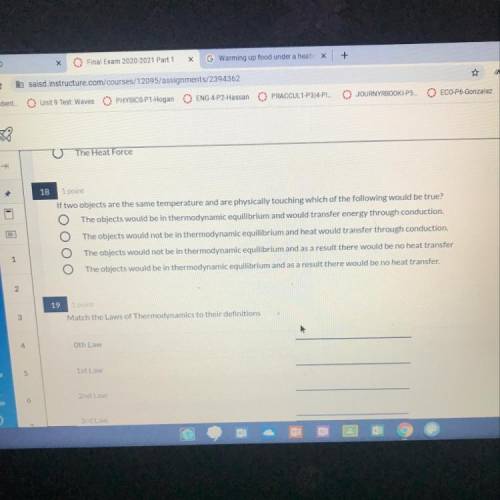The Heat Force
이
18
1 point
-
If two objects are the same temperature and a...

Physics, 02.06.2021 21:10 adriana145
The Heat Force
이
18
1 point
-
If two objects are the same temperature and are physically touching which of the following would be true?
The objects would be in thermodynamic equilibrium and would transfer energy through conduction.
ОООО
1
The objects would not be in thermodynamic equilibrium and heat would transfer through conduction.
The objects would not be in thermodynamic equilibrium and as a result there would be no heat transfer
The objects would be in thermodynamic equilibrium and as a result there would be no heat transfer.
2


Answers: 1


Other questions on the subject: Physics

Physics, 22.06.2019 19:50, naidaisha18
Ahuge (essentially infinite) horizontal nonconducting sheet 10.0 cm thick has charge uniformly spread over both faces. the upper face carries +95.0 nc/m2 while the lower face carries -25.0 nc/ m2. what is the magnitude of the electric field at a point within the sheet 2.00 cm below the upper face? (ε0 = 8.85 × 10-12 c2/n · m2)
Answers: 1

Physics, 22.06.2019 23:30, codnernae2423
An electric power distributor charges residential customers $0.10 per kilowatt-hour (kwh). the company advertises that "green power" is available in 150 kwh blocks for an additional $4 per month. (green power is generated from solar, wind power, and methane sources.) if a certain customer uses an average of 391 kwh per month and commits to one monthly 150 kwh block of green power, what is her annual power bill
Answers: 1

Physics, 23.06.2019 10:40, hsjsjsjdjjd
9. an object is moved from the outdoors, which is at a temperature of 100 ºf, to a room at a temperature of 70 º f. what happens to the object when it’s placed in the room with a lower temperature? the object gives off more energy than it absorbs until it reaches a new lower thermal equilibrium where the amount of energy absorbed and given off is the same. the object gives off the same amount of energy as it absorbs until it reaches a new lower thermal equilibrium where the amount of energy given off is greater than the amount of energy it absorbs. the object gives off more energy than it absorbs until it reaches a new higher thermal equilibrium where the amount of energy absorbed and given off is the same. the object absorbs more energy than it gives off until it reaches a new lower thermal equilibrium where the amount of energy absorbed and given off is the same.
Answers: 1

Physics, 23.06.2019 20:00, whocaresfasdlaf9341
If 25 ml of each of the liquids in the answer choices below were poured into a 100 ml beaker, which would form the second from the bottom layer? a. sea water – density of 1.024 g/ml b. mineral oil – density of 0.910 g/ml c. distilled water – density of 1.0 g/ml d. petroleum oil – density of 0.820 g/ml
Answers: 1
You know the right answer?
Questions in other subjects:










Mathematics, 13.08.2021 01:40




